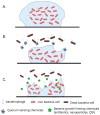Antibiotic-Resistant Pseudomonas aeruginosa: Current Challenges and Emerging Alternative Therapies
- PMID: 40284749
- PMCID: PMC12029751
- DOI: 10.3390/microorganisms13040913
Antibiotic-Resistant Pseudomonas aeruginosa: Current Challenges and Emerging Alternative Therapies
Abstract
Antibiotic-resistant Pseudomonas aeruginosa is a pathogen notorious for its resilience in clinical settings due to biofilm formation, efflux pumps, and the rapid acquisition of resistance genes. With traditional antibiotic therapy rendered ineffective against Pseudomonas aeruginosa infections, we explore alternative therapies that have shown promise, including antimicrobial peptides, nanoparticles and quorum sensing inhibitors. While these approaches offer potential, they each face challenges, such as specificity, stability, and delivery, which require careful consideration and further study. We also delve into emerging alternative strategies, such as bacteriophage therapy and CRISPR-Cas gene editing that could enhance targeted treatment for personalized medicine. As most of them are currently in experimental stages, we highlight the need for clinical trials and additional research to confirm their feasibility. Hence, we offer insights into new therapeutic avenues that could help address the pressing issue of antibiotic-resistant Pseudomonas aeruginosa, with an eye toward practical applications in future healthcare.
Keywords: CRISPR; Pseudomonas aeruginosa; antibiotic resistance; antimicrobial peptides; bacteriophage; nanoparticle.
Conflict of interest statement
The authors declare no competing financial interests.
Figures


Similar articles
-
Evaluation of chlorogenic acid and carnosol for anti-efflux pump and anti-biofilm activities against extensively drug-resistant strains of Staphylococcus aureus and Pseudomonas aeruginosa.Microbiol Spectr. 2024 Sep 3;12(9):e0393423. doi: 10.1128/spectrum.03934-23. Epub 2024 Jul 24. Microbiol Spectr. 2024. PMID: 39046262 Free PMC article.
-
HOCl-producing electrochemical bandage is active in murine polymicrobial wound infection.Microbiol Spectr. 2024 Oct 3;12(10):e0062624. doi: 10.1128/spectrum.00626-24. Epub 2024 Aug 20. Microbiol Spectr. 2024. PMID: 39162542 Free PMC article.
-
In vitro investigation of relationship between quorum-sensing system genes, biofilm forming ability, and drug resistance in clinical isolates of Pseudomonas aeruginosa.BMC Microbiol. 2024 Mar 25;24(1):99. doi: 10.1186/s12866-024-03249-w. BMC Microbiol. 2024. PMID: 38528442 Free PMC article.
-
Antimicrobial resistance of Pseudomonas aeruginosa: navigating clinical impacts, current resistance trends, and innovations in breaking therapies.Front Microbiol. 2024 Apr 5;15:1374466. doi: 10.3389/fmicb.2024.1374466. eCollection 2024. Front Microbiol. 2024. PMID: 38646632 Free PMC article. Review.
-
Treatment of Pseudomonas aeruginosa infectious biofilms: Challenges and strategies.Front Microbiol. 2022 Aug 26;13:955286. doi: 10.3389/fmicb.2022.955286. eCollection 2022. Front Microbiol. 2022. PMID: 36090087 Free PMC article. Review.
References
-
- Araos R., D’Agata E. Pseudomonas aeruginosa and Other Pseudomonas Species. 2019. [(accessed on 9 April 2025)]. Available online: https://scholar.googleusercontent.com/scholar?q=cache:zPAFS5s4TcYJ:schol....
Publication types
LinkOut - more resources
Full Text Sources
Research Materials

